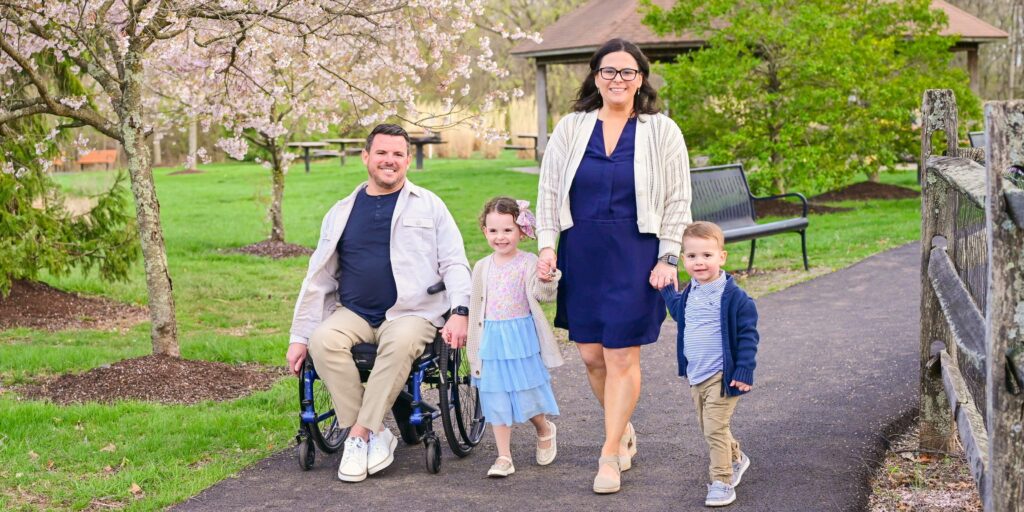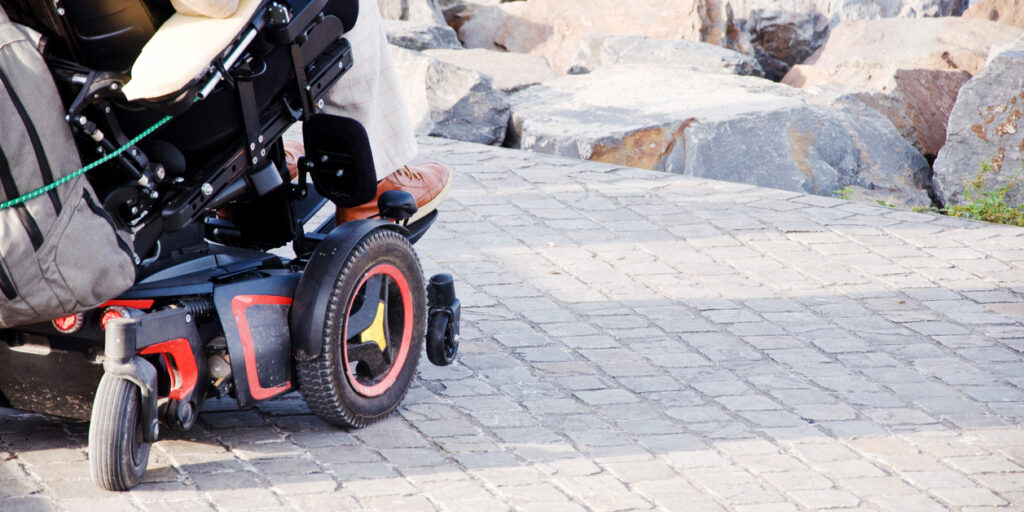
Wheels Like Mine
By Katrina Gossett-Kelly | Friday, October 11, 2019
I am a mom. I have spinal muscular atrophy (SMA). My son has SMA, too.
Because SMA is a genetic disorder, these statements may not seem surprising. It wouldn’t be all that strange for a person with SMA to pass on their condition to their child. But that is not our story. Our journey to family is more convoluted and, dare I say, even more beautiful than most would guess. Ours is a story of love and adoption and beauty where others see tragedy.
The Stars Align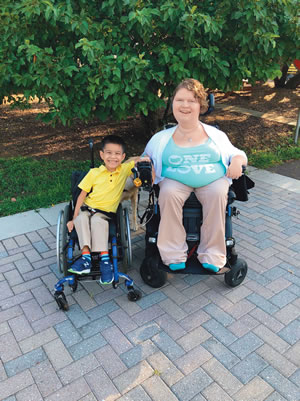
I’ve wanted to be a mother all my life. When I was 5, I didn’t have imaginary friends; I had imaginary children ranging from ages 3 to 16. In the following years, I assembled quite the family of Cabbage Patch Kids. I never viewed SMA as a barrier to parenting. But, of course, things were a bit easier when my kids were imaginary or made of plastic.
Two decades later, I met my husband, Russel. Shortly after we were married, we got “baby fever” and had to come up with a plan for becoming parents. I had already decided that pregnancy wasn’t for me. Russel and I had both considered adoption, as it was a part of our families. We were drawn to international adoption, and, in particular, Bulgaria, because it is more open to parents with disabilities.
I pored through pictures of children available for adoption in Bulgaria. Most of them have disabilities, as it is harder for them to find families because of cultural stigma. I had no qualms about adopting a disabled child, but I was not necessarily looking for a kiddo just like me. That is, until fate stepped in.
I saw his profile. He was an adorable 4-year-old named Gosho, and his profile said he was a caring little boy who loved to assist his visually impaired friend reach his toys. My heart was aflutter. And then I read the next sentence: “This little boy has spinal muscular atrophy.” My heart stopped, then it burst wide open. I was looking at my son. I’d never thought about adopting a child with SMA, but there he was, and I had no choice.
This was the start of our family.
Challenges and Successes
I’ll be the first to admit that it’s not always simple to parent a child with the same disability. There are times when Gosho is having a bad day, and I just want to scoop him up into my arms and hug him tight. Instead, we work around it. We hold hands. He rests his head on my feet when he needs a good cry. And Daddy lifts him up to give me a hug every night before bed.
I also asked local engineering students to design a seat for Gosho that attaches to my wheelchair so I can carry him around. He loves going on adventures on Mommy’s wheelchair.
There are other smaller challenges. I can’t help him open his snacks, so I bought a pair of scissors he can use. I can’t pick him up when he falls, but I can give him a footrest boost and some pretty awesome cheers. In fact, Gosho has become more independent because he knows he can’t rely on my physical help to do things.
Sometimes, his disability actually makes it easier for me to parent him. I can stop him from running into traffic by blocking his wheelchair with my own. When he is having a meltdown, I can keep him in place and get down to his level so that we can work through it. On those days, I am grateful that I can outrun my spirited little boy.
Roll Modeling
There are also moments when I am humbled by the opportunity to raise a little boy with the same disability as me, one who will face many of the same challenges. In those moments, I am grateful that I’ve been down the same accessible (and sometimes inaccessible) paths, where I can be a role (or roll) model.
Recently, we were talking about his last days of kindergarten and how he is getting bigger. Out of the blue, Gosho asked, “When will I walk?”
I paused. I had wondered the same thing when I was little. I wished I could give him the answer he wanted to hear, but at least I could give him the answer he needed: “Well, you might never walk. But, do you know what — I never walked, and it’s OK.”
I reminded him that’s why he has a wheelchair and that he does a great job getting around. Instead of being disappointed, he quickly pivoted to telling me how fast he can go on the ramp at school. I felt blessed to be able to navigate that difficult question from my own wheelchair.
My experiences will also guide Gosho to become a strong advocate. He will attend every individualized education program meeting. He will push for change. He will speak up for himself. He will speak up for others. Growing up, I faced the same naysayers he will encounter, but he will be ready.
Beauty, Not Tragedy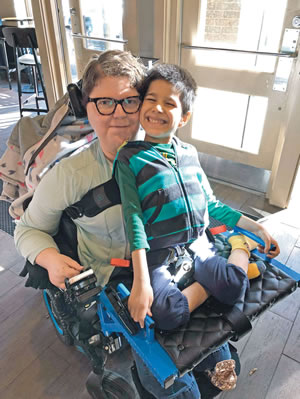
I think some people view our family with pity, but they are missing the big, wonderful picture. Not long ago, Russel met with a shortsighted respiratory therapist. He explained that he didn’t need much training on equipment for Gosho because his wife uses a lot of the same equipment. She responded, “Aw, how sad.” Russel was taken aback.
I wasn’t there, but I wish had been to tell her that the better response would have been, “How cool.” How cool is it that a mom and son can share these experiences and learn together? How cool is it that his dad gets to be a part of that? How cool, and moreover how beautiful, is it that my son has wheels like mine?
Quest loves to hear stories from around the MDA community. If you’d like to share your story with Quest, contact us at quest@mdausa.org.
Katrina Gossett Kelly is a business litigation attorney at Faegre Baker Daniels in Indianapolis. She also performs improv at ComedySportz Indianapolis and serves as a disability advocate throughout Indiana. Her favorite job of all, however, is being mom to 7-year-old Gosho.
Primed for Parenting
Anybody with kids will tell you that being a parent is the toughest job they’ve ever loved. Navigating parenthood while living with limited mobility due to neuromuscular disease adds an extra challenge. Here are four strategies from people who have been there.
1. Cultivate your verbal skills. Parenting is every bit as verbal and emotional as it is physical. If your limb movement is restricted, consider delegating tasks such as feeding and bathing to a caregiver while you take on the all-important roles of ouchie-soother, homework helper and pep talker.
Melanie Carson breaks down instructions to her 2-year-old, Silas, into single actions. “I’ll say, ‘Pick up your shoes. Now walk to the closet. Set the shoes inside. Now close the door,’” says Carson, whose movement is slow because of limb-girdle muscular dystrophy (LGMD).
James Parsell’s Duchenne muscular dystrophy (DMD) prevents him from cooking, but he can guide his 9-year-old son, Christofer, through making his own simple meals.
“Most neuromuscular diseases are physical, not mental,” says physical therapist Polly Swingle, CEO of The Recovery Project in Detroit. “These parents are in fact the ideal candidates to be sitting alongside their child with the timer, saying, ‘You do numbers 1 through 10 while I check your finished work.’”
2. Don’t shy away from mobility aids. In her work at Michigan-area MDA Care Centers, Swingle frequently encounters adults who are resistant to using mobility devices. “They fear becoming dependent on the device,” she says.
Swingle aims to show her mom and dad patients that braces, walkers, wheelchairs and accessible vans are not to be feared, and can even facilitate awesome interactions with their children. “That chair or van might be the only thing between you and your kid’s softball game,” she says.
3. Invite the therapist over. Give your physical and occupational therapists a tour of your home. “That’s the only way we can see the specific obstacles and opportunities in your house and come away with a completely customized strategy,” Swingle says.
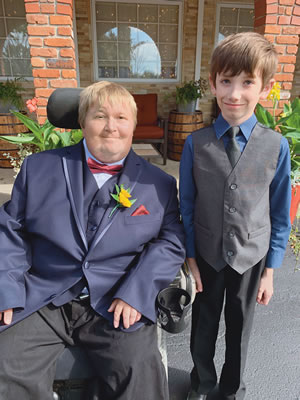 Furnishings and accessories like mini fridges, strap handles, roll-out drawers and low-height cribs and changing tables are just a few of the things therapists can suggest to help with the daily tasks of childrearing.
Furnishings and accessories like mini fridges, strap handles, roll-out drawers and low-height cribs and changing tables are just a few of the things therapists can suggest to help with the daily tasks of childrearing.
Therapists will often suggest home visits during consultations, but if not, just ask.
4. Help me, help you. Enlisting kids to help with physically challenging tasks is a great way to teach them needed skills. “I used to have Christofer help me put my shoes on when he was learning to tie his shoes,” Parsell says.
Carson encourages Silas to bring her objects from the couch and other low furniture to conserve her energy and teach him the safe way to climb. “He learned how to safely climb into the pool from swim lessons, and I’ve taught him that’s the same way to climb off furniture,” she says.
TAGS: Featured Content, Parenting, Relationships
TYPE: Featured Article
Disclaimer: No content on this site should ever be used as a substitute for direct medical advice from your doctor or other qualified clinician.


